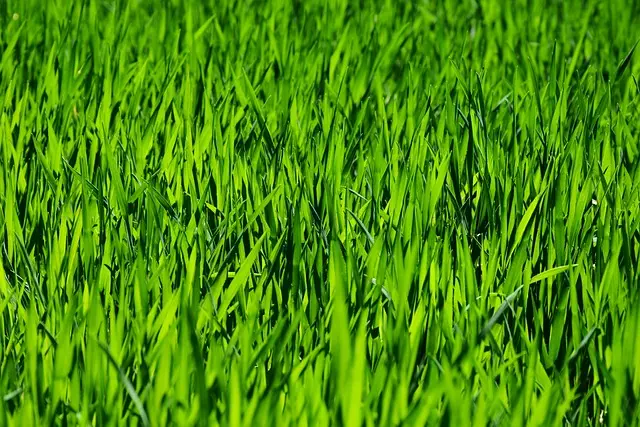Effective lawn care and landscaping require a tailored approach that considers grass types, regional climate factors, and soil properties for optimal turf health. This includes precise mowing practices, aeration, overseeding, strategic fertilization, and efficient irrigation to maintain vibrant grass under various conditions. Seasonal maintenance is crucial; for instance, clearing debris in spring, adjusting mowing patterns in autumn, and applying a winterizer fertilizer before cold weather sets in. Advanced disease management techniques, such as laboratory testing and imaging technology, are essential for diagnosing and preventing turfgrass diseases. Integrated pest management (IPM) strategies complement these efforts, ensuring the lawn can withstand environmental stressors while retaining its aesthetic appeal throughout the year. Fertilization should be nutritionally targeted and guided by consistent soil testing to support plant growth, root development, and overall turf health, avoiding over-fertilization and its environmental impacts. By adhering to these best practices in lawn care and landscaping, professionals can create sustainable, visually appealing outdoor spaces that enhance property value and contribute positively to the local ecosystem.
Exploring the multifaceted field of turf management, our article delves into the essentials of optimal lawn care, seasonal maintenance strategies, disease prevention, and fertilization techniques. With a focus on enhancing both aesthetic appeal and functional performance, it also examines advanced methods in turfgrass health and landscaping practices that contribute to vibrant, resilient lawns. Whether you’re a homeowner or a professional, understanding Lawn Care and Landscaping best practices is key to achieving and maintaining the perfect green space.
- Understanding the Basics of Turf Management for Optimal Lawn Care
- Seasonal Maintenance Strategies for Healthy and Resilient Lawns
- Advanced Techniques in Turfgrass Disease Identification and Prevention
- The Role of Fertilization and Soil Testing in Maintaining Vibrant Lawns
- Landscaping with a Focus on Turf Management for Aesthetic and Functional Outcomes
Understanding the Basics of Turf Management for Optimal Lawn Care

Engaging in lawn care and landscaping requires a solid foundation in turf management, an essential practice for maintaining healthy and aesthetically pleasing lawns. At the heart of effective turf management is a deep understanding of the specific grass types, local climate conditions, and soil characteristics that influence growth patterns. Proper mowing techniques, for instance, involve cutting the grass at the correct height and frequency to encourage robust root development and optimize photosynthesis. Aeration, overseeding, and fertilization are other critical components of a well-rounded turf management program, each serving to strengthen the lawn’s resilience against pests, diseases, and environmental stressors.
Moreover, irrigation strategies play a pivotal role in turf management. Efficient watering practices not only conserve valuable resources but also prevent overwatering or underwatering, both of which can compromise lawn health. Additionally, integrating pest and disease management into routine care helps to prevent infestations and infections that could otherwise threaten the integrity of the turf. By staying informed on best practices for lawn care and landscaping, homeowners and professionals alike can ensure their grass remains lush, vibrant, and resilient throughout the changing seasons.
Seasonal Maintenance Strategies for Healthy and Resilient Lawns

Engaging in seasonal maintenance strategies is pivotal for fostering healthy and resilient lawns, a testament to one’s expertise in lawn care and landscaping. During the spring, lawns should be wakened from dormancy with careful raking to remove debris, followed by thorough aeration to allow air, water, and nutrients to penetrate the soil. Over-seeding areas of thin turf with a mix of grass varieties that are well-suited to local conditions can enhance the lawn’s resilience against pests and diseases. Fertilization should be timed to coincide with seasonal growth patterns, promoting lush, green growth without overstimulating.
As the summer progresses, maintaining an optimal mowing height and frequency becomes essential for grass health. Regular irrigation, particularly during periods of drought, is crucial to ensure the lawn remains hydrated without becoming waterlogged. Integrating pest and weed control measures tailored to seasonal challenges can safeguard against intruders that threaten turf health. Similarly, as autumn approaches, preparing the lawn for the colder months involves reducing mowing frequency, raking leaves regularly to prevent matting, and applying a winterizer fertilizer to fortify the grass roots ahead of the freeze-thaw cycles. Throughout all seasons, proactive lawn care and landscaping practices underscored by knowledgeable turf management can lead to a vibrant, resilient landscape that withstands environmental stressors and remains aesthetically pleasing year-round.
Advanced Techniques in Turfgrass Disease Identification and Prevention

Turfgrass diseases can pose significant challenges to maintaining healthy, resilient lawns. Expertise in turf management now encompasses advanced techniques for disease identification and prevention, which are crucial for effective lawn care and landscaping. Utilizing cutting-edge diagnostic tools such as laboratory testing and advanced imaging allows for precise identification of pathogens. This precision enables timely and targeted interventions, reducing the impact of diseases on turfgrass health. Moreover, understanding the environmental conditions that favor disease development is key to preventative strategies. Factors like humidity, temperature, and soil moisture are closely monitored to forecast potential outbreaks, allowing for proactive rather than reactive management. Integrated pest management (IPM) approaches incorporate cultural practices, biological control agents, and judicious use of fungicides tailored to the specific disease pressures present. These advanced techniques in turfgrass disease identification and prevention are integral to high-quality lawn care and landscaping, ensuring that turf remains lush, vibrant, and sustainable over time. Landscaping professionals with this expertise can safeguard against disease outbreaks, providing homeowners and sports fields with consistently healthy turf.
The Role of Fertilization and Soil Testing in Maintaining Vibrant Lawns

Maintaining a vibrant and healthy lawn requires a strategic approach to fertilization and regular soil testing, which are foundational aspects of effective lawn care and landscaping. Fertilization is not merely about spreading nutrients across the turf; it’s about understanding the specific needs of the grass species present and providing the right balance of macro and micronutrients at the optimal timing throughout the growing season. A well-devised fertilization program supports plant growth, enhances root development, and improves overall turf density and resilience, contributing to a lush and green lawn.
Soil testing is an indispensable component of comprehensive lawn care and landscaping practices. It offers insights into the soil’s composition, pH levels, and nutrient content, which are critical for healthy plant growth. By analyzing these factors, landscape professionals can tailor their fertilization strategies to address any deficiencies or imbalances in the soil. This targeted approach not only ensures that grass receives the necessary nutrients but also prevents over-fertilization, which can lead to environmental issues and unhealthy plant growth. Regular testing allows for proactive rather than reactive lawn care, fostering a robust ecosystem beneath the turf that supports its vibrancy and longevity.
Landscaping with a Focus on Turf Management for Aesthetic and Functional Outcomes

Lawn care and landscaping practices that prioritize turf management offer a dual benefit for both aesthetic appeal and functional utility in outdoor spaces. Effective turf management begins with understanding the specific grass varieties and soil types present in a landscape, tailoring care strategies to optimize growth and resilience. Regular mowing at optimal heights, appropriate fertilization, and targeted watering regimens are essential for maintaining a lush, green lawn that serves as a visually pleasing backdrop to any property. Additionally, integrated pest management (IPM) techniques help protect the turf from invasive species, ensuring the longevity and health of the grass ecosystem. Landscaping professionals with expertise in turf management employ these strategies to create environments that are not only beautiful but also sustainable and easy to maintain over time. The result is a harmonious landscape that enhances property values, provides recreational spaces for enjoyment, and supports ecological balance.
Effective turf management is a cornerstone of exceptional lawn care and landscaping practices. This article has outlined the essential elements for cultivating healthy, resilient, and visually pleasing lawns. From mastering the basics of turf management to implementing seasonal maintenance strategies and employing advanced techniques in disease management, the insights provided ensure that your lawn not only withstands environmental challenges but also serves as a beautiful addition to any landscape. Fertilization and soil testing, when conducted thoughtfully, further enhance the vibrancy of your turf. By integrating these practices into your routine, you’ll achieve the lawn of your dreams—a testament to the harmony between science, nature, and aesthetics in lawn care and landscaping.


